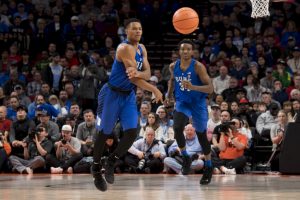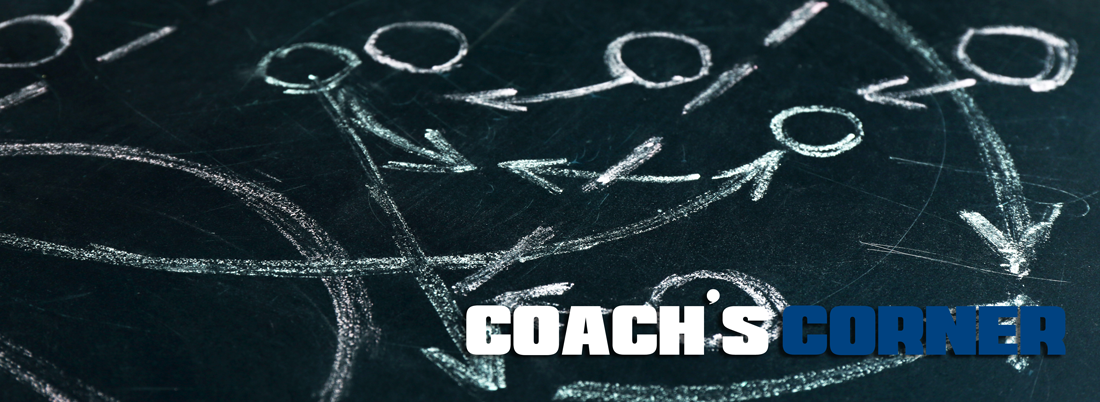So far in the Coach’s Corner we’ve taken a look at how Duke’s freshmen forwards started the season offensively, and some key in-game adjustments that improved the 2-3 zone against Michigan State. Over the course of the PK80 tournament last week I wanted to focus in on Trevon Duval. Duval got off to a tremendous start, averaging 13 points, 10 assists steals a game in the first three games. In stark contrast to those 30 assists he took great care of the ball with only 4 total turnovers.
The one area where he showed a glaring weakness to date has been outside shooting (3/23, 13%). I’m not going to spend much time on that – maybe in a future Coach’s Corner. Suffice to say it’s something that can only be fixed with reps and confidence.
In the two games after the Michigan State game his scoring remained steady (14 ppg) but as with many freshman guards, his distribution and ball security began to fluctuate. So I went back and focused just on him for every possession of the PK80 to get a better idea of what is, and isn’t, working.

Let’s start with the most obvious strength – passing. Duval showed a lot of poise in the half court orchestrating the offense. It’s clear that Duke is intent on playing inside-out, and Duval embraces that. He gets the team into sets on the offensive end and is able to get them into multiple looks. When he’s got the ball at the top of the key he’s not in a hurry to make an entry pass. He delivers the ball on time and on target but he’s not forcing passes inside early from poor angles.
In transition he really seems to find the cross court pass early. He hit several 30+ foot diagonal passes in this tournament and I can think of at least one play that was very similar in the Michigan State game that led to a Grayson Allen three. It’s tough enough as a defense to recover the ball on the dribble. When the ball gets skipped early in transition against a recovering defense, it’s almost impossible to get a solid closeout. By changing the angle of the attack he opens up all kinds of opportunities for teammates. His recent turnovers don’t have me too worried. Several were offensive fouls; dead ball turnovers are much less damaging than live ones. He also had a couple of soft passes in transition that seemed to be more about execution than decision making.
Much like his patience on entry passes, Duval does not seem to force the action to the basket off the bounce in half court sets. While there are times he could attack screens with more intent, he’s certainly not just putting his head down and blindly running into help defenders off of them. When he does drive he seems to prefer jumping from further up the lane and gliding to the basket. This can put him in some awkward positions and leads to tough shots. He doesn’t generate much power on those lateral jumps and struggles to elevate if he gets into the body of a defender. It could also lead to being susceptible to offensive fouls.

If he brings the ball across the half court line in transition he wants to score. Duval seems to prefer to catch outlet passes with his back to the left sideline. This allows him to make crossover moves from his left to right hand, which he seems much more comfortable with. As I said before he tends to glide into layups but certainly has the ability to finish above the rim as well. His scoops and finger rolls around the rim will be difficult finishes over forwards but on the break those are tough to defend.
Off the ball offensively he has the potential to be a real menace but he is often stagnant. After making the initial entry he tends to end up standing in a corner as a spectator. Because of his shooting struggles opponents are not paying him much attention as a floor spacer. Texas and Florida (two teams with strong defensive coaches and schemes) both sent his man to double in the post. This was especially true when he cut through on UCLA cuts and ended up in the opposite corner. Marvin Bagley III and Wendell Carter Jr. especially are good enough passers to find flashing cutters even over a double team. When Duval catches the ball on those cuts he’s very effective and routinely finished or drew fouls. In particular, he came up with a huge offensive rebound put back late against Florida because he was making a flash cut along the baseline when his man went to double on the opposite block. That play was a big spark and helped build the momentum as Duke closed the game on a big run. If he’s not scoring he will be able to find the other post player, leading to easy baskets and happy bigs.
On the defensive end Duval is like a lot of freshmen. When he’s engaged and on the ball he is at his best. Off the ball he clings to his man and can be slow to rotate as the first line of help. He isn’t a very active defensive rebounder but he doesn’t need to be with Duke’s length inside. What’s interesting to me is that when Duke goes zone he becomes much more active away from the ball. He challenges passing lanes and generally has more activity on each possession. Sometimes that leads to late lunges for passes he’s never going to get, but he also deflects and disrupts a lot of passes. It’s a give and take – as long as he’s not running through passing lanes it shouldn’t be too big of an issue.
During the Texas game ESPN’s crew talked about how Duval chose Duke in part to help his image. They quoted him as saying he needed Duke just as much as they needed him. For a player who is a potential 1st round pick, I don’t know how true that is. But as a Duke fan I’m certainly glad he felt that way. Duke is traditionally at it’s best when it has a floor general. Duval can direct the offense, deliver the ball to Duke’s many weapons, and has the ability to score the ball himself once others are involved. That sounds like the type of general the Blue Devils can follow into battles all year long.


